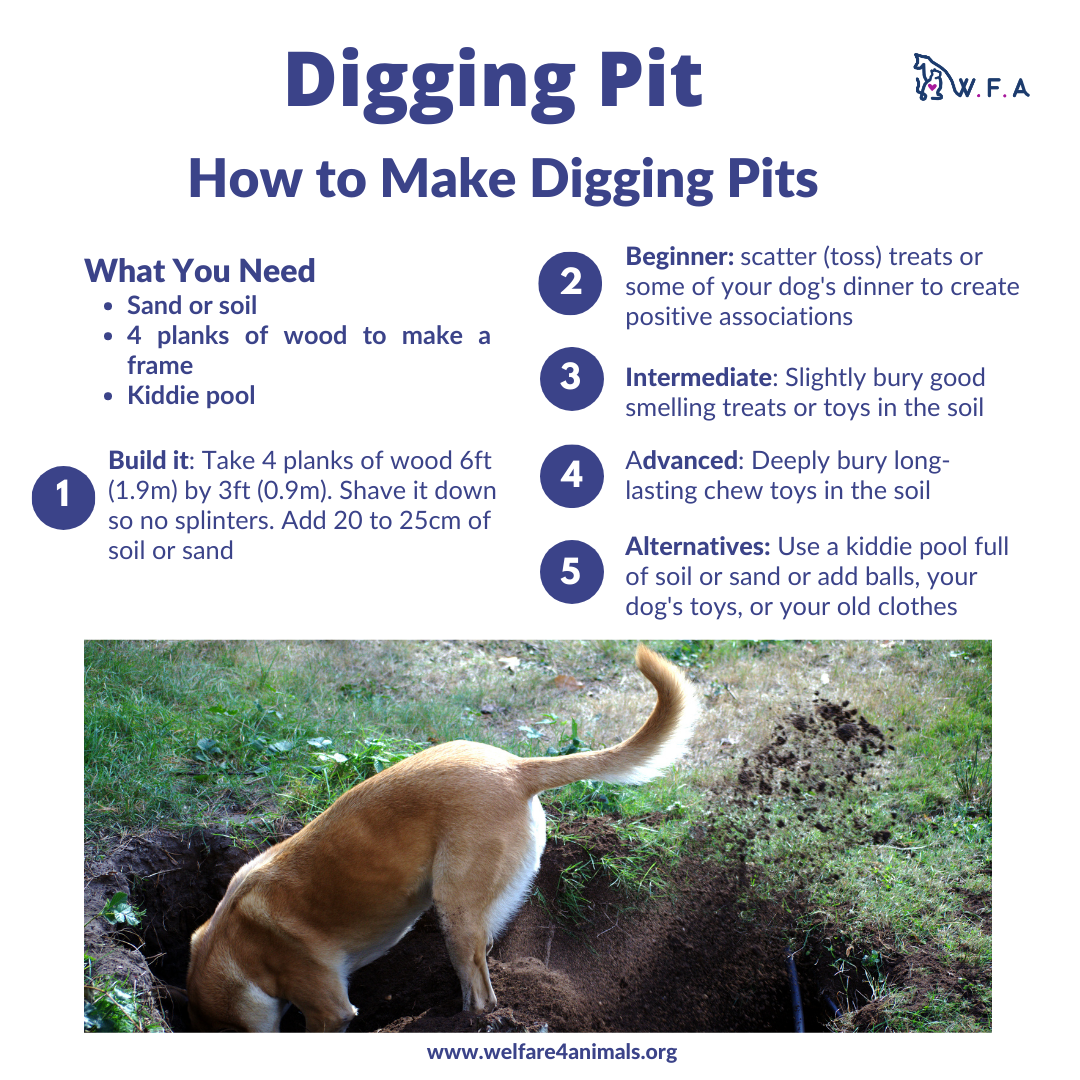Is Your Dog a Digger??
Has your dog decided that there should be potholes scattered across your backyard? That they should “rearrange” your flower bed? Or that grass is their #1 enemy??
It can be highly upsetting and frustrating if your dog uproots all of the flowers and vegetables that you had just planted and spent a lot of money on. Or when you’re trying to go for a nice walk and your dog finds loose dirt and becomes a muddy mess. For some dogs, digging by the fence, or digging up and eating plants that are poisonous even be very dangerous. So, when your dog digs, it is important to pay attention to WHY they’re digging and provide them with an outlet.
Why do dogs dig?
Genetics & Prey Drive
For many dogs, digging is a part of genetics and breed characteristics. Dogs such as terriers, beagles, daschunds and schnauzers are genetically wired for digging, and were specifically bred in the role of diggers to hunt game or rodents like rats. Also, dogs with their excellent hearing can also hear or smell prey underneath the ground, like moles or mice, and so they dig to try to get to prey.
It's fun
For dogs it’s lots of fun, rewarding and self-reinforcing to dig. Ever watched a dog dig? They’re having a great time! Also, if they’re bored, what better way to decrease their boredom and have a bit of fun than to go for a nice dig in the garden.
It’s a stress reliever
For some dogs, digging can also be a stress relief. Dogs who are frustrated, have high-energy or don’t have enough enrichment outlets they’ll dig as a stress reliever. If you haven’t taken your dog out for a walk, or only do runs/fast walks where your dog can’t sniff they’ll have high arousal levels or provided them with enough enrichment to meet their needs, they will find their own means of stress/arousal relievers, entertainment and outlets, which is not their fault. Your dog isn’t digging to spite you, which is anthropomorphizing (placing human emotions onto another object or species), they’re digging to release an emotional state- like how you may go for a run or to the gym when you’re stressed.
Some dogs who have anxiety or a lot of stress in the home environment, may even try to dig underneath a fence as a way to escape. Many dogs who have anxiety based behaviours often dig at exits like doors, windows or fences, so this is the context of where your dog digs and at what times they dig is very important to understand their behaviours.
It’s cool
For dogs on a hot summer day, the best place to rest is in a nice place in the shade in the dirt. Dogs can only release heat in their bodies from sweat glands in their paws and panting, so your dog may dig a little hole in the grass or an area in your garden to remove topsoil and access cooler soil underneath to help them cool down.
What to do?
Digging is one of those behaviours WE find frustrating but are a natural behaviour in dogs. Not allowing your dog to release natural intrinsic behaviour that they’re genetically hardwired to do will only increase their frustration and stress which will lead to other stress-related behaviours like frustration barking, fear barking, barking and lunging on walks or digging around your carpet or the couch.
Too many times in dog Facebook groups I’ve seen people asking about how to stop their dog from digging and other dog guardians or individuals saying to use all sorts of aversive-based equipment like shock fences, spraying Bitter Apple or cayenne pepper onto plants are good solutions. They’re not. They are all punishment based concepts that will place your dog into behavioural fallout, will lead to mistrust, and an increase of fear and aggression.
To find out more about behaviour fallout and studies that support why you should NEVER use aversive-based solutions click here.
Also, all of these solutions can potentially cause serious harm to your dog! If your dog ingests any cayenne pepper or Bitter Apple solution, this may be toxic for them and require an immediate vet visit. Anything shock related is illegal in many countries in the world, as well as all veterinary associations and animal welfare organizations advocate for it to be banned due to the physical, mental and behavioural harm it does to a dog. Don’t use any of these methods as they can and will harm your dog.
Using force or any form of punishment to STOP a behaviour teaches a dog nothing, except to teach your dog to fear you, damages the bond and trust between you and your dog, increases stress as dogs do not have an outlet for natural behaviours or puts your dog into immense daily fear or learned helplessness (emotional and physical shutdown) due to not knowing when they will be punished. This is why you should never use punishment based methods on your dog.
Training is sadly not a regulated industry, and anyone can say that they’re a trainer without any education, or that since they’ve had dogs, they know what to do. The Internet is full of horrible harmful ideas of how to stop your dog from digging. This is why if your dog digs or does something you don’t think is appropriate, it is very important seek out certified and experienced positive reinforcement force-free trainers for advice and not strangers online who have no education. I wouldn’t take my car to a random person that I just met on the street for a tune-up, so why would you take some random person’s advice for your dog who is a sentient being?
An alternative and safer option for advice than random people on social media or the unknowns of the Internet is Dogly! Dogly is a vetted community based online platform where dog guardians can connect with force-free certified experts. If you join as a Dogly Community member you get access to all Advocated (certified experts) Communities and Support Groups.
You can access our future Support Group click here.
Remember, stopping or punishing your dog from digging isn’t a solution, will only lead to an increase in stress which will then spill over into other undesired behaviours.
The 5 Welfare Needs, as detailed in the Animal Welfare Act in 2006, details that it is the owner (or guardian)’s responsibility to provide for the needs of their pet, what their needs are and how to meet them.
For more information on the 5 Welfare Needs click here.
If your dog is a digger, this is a natural behaviour (or using the 5 Welfare Needs- a normal behaviour pattern) and an outlet that should be provided to help your pet’s mental, emotional, behavioural and physical well-being. The best, humane and must behavioural fullfilling option to help your MAJOR DIGGER is to build them a digging pit!
So how to make a digging pit??
It’s so simple to learn how to make a digging pit, where your dog can dig. If you make your dog a digging pit, NO your dog won’t soon start digging all over your garden even more. Dogs learn by associations so if you reinforce to your dog that this is their area to dig and reinforce that, they will learn that they should dig there. If when your dog is learning and digs elsewhere, be patient with them and simply lure them or toss some amazing treats into their digging pit and use the cue DIG so they know that is their location to dig.
Our friends at Barket Place have a great video on why dogs dig and how to build a digging pit, click here
How to build: Use 6ft (1.8m) and 3ft (0.9m) planks of wood and simply build it into a square. Add 20 to 25cm of soil or sand as the digging pit. If you have a larger dog or want to make it larger, then simply buy larger pieces of wood to build a square or rectangular frame.
How to train your dog to use it:
Beginner: Do a scatter feed or toss food, treats, toys, some of your dog’s dinner over the digging pit to build reinforcement and associations. Do this at least 1-3times a day to build associations for one week. After you do this 5 times successfully, add in the cue “Dig” and point your finger at the digging pit. Dogs first learn behaviours and once they successfully understand a behaviour, a cue can be brought in!
Intermediate: Slightly bury their toys and high value treats to slightly increase the difficulty but don’t make it too frustrating by burying them too deep.
Advanced: Deeply bury several long-lasting chew toys in the soil so your dog really has to dig for them and has a great time digging and digging. This is a great idea if you have guests over or your dog needs to decompress.
Check out the phenomenal A Canine Affinity on Tik Tok for an example of an amazing digging pit, click here
What if you don’t have a garden/yard?
Kiddie pools: use the circular, thick plastic circles with lids, as these won’t break as much and aren’t a safety hazard. You can add plastic balls or if your dog eats those, then use their own toys and scatter treats or their own dinner over it and let them sniff and dig it out.
Make a digging box: use a big cardboard box, get an old rags, shirts or towels. Layer tasty treats in the bottom of the box, cover with a layer of rags, put another layer of treats or kibble on top of that layer, layer with more rags/towels/old clothes, place more kibble and treats on top and continue until you feel is enough. Start small and easy like a few treats on top and in the middle, then increase in difficulty so your dog doesn't get frustrated. Let your dog sniff, dig and throw the old rags away.
Digging box with paper: this is similar to the digging box with rags/towels/old clothes, but instead of fabric use all of the non-toxic coloured paper you have, place layers of treats and kibble like the digging box above and let your dog dig and shred to their heart's content. Use the cue “Trade” if they start to eat the paper.
Photo credit our friends at: https://www.facebook.com/For-the-Love-of-Dog-37826905774/
When using these options, you are not teaching your dog to go and chew every piece of paper, clothing or blanket they see. Your dog learns through associations, and you are teaching them that when you do this - put treats into a ball pit or into cardboard box with paper- they can shred and dig to their heart's content.
Remember, your dog should never be scared or frustrated of enrichment, as that is the complete opposite of enrichment!
Let's start digging!
If you need help for your digging dog message us to book a virtual or in-person (only serving YYC area) consult.
If your dog pulls a lot on the leash or gets really stressed on walks check out our online course here



